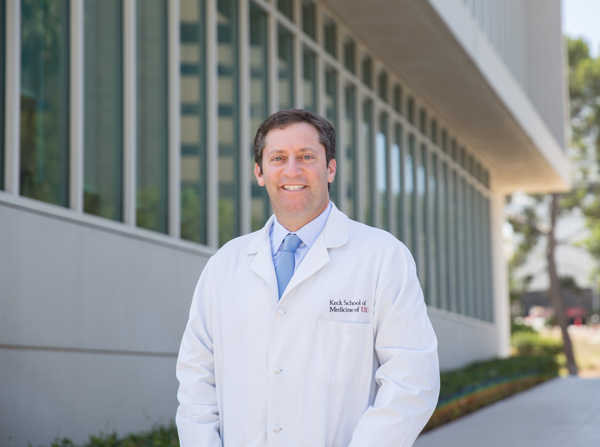 If you doze off during a consultation with Eric Kezirian, MD, MPH, he won’t take offense. As the head of Sleep Surgery in the USC Caruso Department of Otolaryngology – Head and Neck Surgery, it’s his job to help patients sleep better. Kezirian uses the latest techniques — and is helping pioneer new ones — to treat snoring and obstructive sleep apnea.
If you doze off during a consultation with Eric Kezirian, MD, MPH, he won’t take offense. As the head of Sleep Surgery in the USC Caruso Department of Otolaryngology – Head and Neck Surgery, it’s his job to help patients sleep better. Kezirian uses the latest techniques — and is helping pioneer new ones — to treat snoring and obstructive sleep apnea.
Snoring can be a major issue for patients as well as anyone who is trying to sleep nearby. Snoring is generally considered a nuisance, but it can be a sign of something more serious: obstructive sleep apnea.
Sleep apnea is the blockage of breathing that can wake us up and disrupts the body’s oxygen flow. Its ramifications range from fatigue, headaches and difficulty concentrating to increased risks of stroke, heart failure and, possibly, even cancer. The condition is on the rise, affecting up to billion people worldwide — 10 times more than the World Health Organization estimated in 2007.
“Many risk factors for sleep apnea are becoming more common,” Kezirian says of the growing prevalence. These include an aging population and increasing rates of obesity. “By age 60, approximately 40 percent of people have moderate to severe sleep apnea,” he explains.
The key to Kezirian’s clinical approach — and his research — is determining what is likely to work best for each individual. “You don’t treat everybody the same way because that just does not work,” he says.
When it comes to planning for surgery, this might require a trip to the operating room for an evaluation called drug-induced sleep endoscopy. “You sedate patients in a careful way that is close to natural sleep,” he says. “Then I look with a telescope inside their throat to see what is causing their sleep apnea so that we can come up with a focused but effective treatment.”
Kezirian is considered an international leader in drug-induced sleep endoscopy and personalized medicine approaches to sleep apnea and snoring. He recently led a global study examining how drug-induced sleep endoscopy can be used to guide the selection of surgical procedures and predict the results of surgery. With 275 patients and 14 centers around the world, the project is the largest in the field to date.
“The study had a couple of key findings,” he says. “We confirmed something that we have suspected but never properly studied – that surgery does not work well if the sides of the patient’s throat are collapsing. And if the tongue is falling back to block breathing — which it commonly does — the results are better when you treat that instead of ignoring it.”
With his focus on sleep surgery, Kezirian uses a wide range of procedures to treat patients, whether by removing, tightening or repositioning tissue. He also works with companies in their research to understand the benefits of new approaches. One of these is Inspire Medical’s Upper Airway Stimulation (UAS) System that is implanted in the body with a surgical procedure. UAS keeps the space for breathing in the throat open by mildly stimulating the nerve that controls tongue movement. “It’s somewhat similar to a tongue pacemaker,” Kezirian says. UAS is a relatively new technology, gaining FDA approval in 2014, and Kezirian also is serving as investigator in a multi-center study of its effectiveness.
The most common treatment for sleep apnea, though, remains continuous positive airway pressure (CPAP), a machine that is worn at night to help with breathing. “It is low-risk and still the first-line option for people with significant sleep apnea,” Kezirian says.
Some patients find the CPAP mask uncomfortable, and studies have shown that about 30 percent of patients cannot sleep well while wearing CPAP. “It does not work well for everybody,” Kezirian admits. “So that is when you think about other options.”
Those options include surgery and customized oral appliances like the mandibular advancement device, which holds the lower jaw slightly forward during the night to keep the airway open.
“Often, we combine methods,” he notes. “Surgery with an oral appliance is a common approach to get the results the we want.”
As a specialist at a leading academic medical center, Kezirian takes on the most challenging cases — including patients who have not responded to previous surgery and other treatments. “Send your most difficult cases,” he says with a chuckle. “I will be honest with them, explaining whether additional surgery might work well or finding another way.”
Of course, not all restless nights are due to sleep apnea. For people who snore but don’t have sleep apnea, surgery is typically a good option. However, Kezirian may first recommend “weight loss, sleeping on your side, avoiding alcohol within three hours of bedtime and other things that are healthy for anybody.”
Kezirian is as dedicated to educating the public about snoring and sleep apnea as he is to ensuring peaceful dreams for his patients. He even blogs and produces Youtube videos featuring tips and research information.
To make a gift to the Caruso Department of Otolaryngology – Head and Neck Surgery, click here.